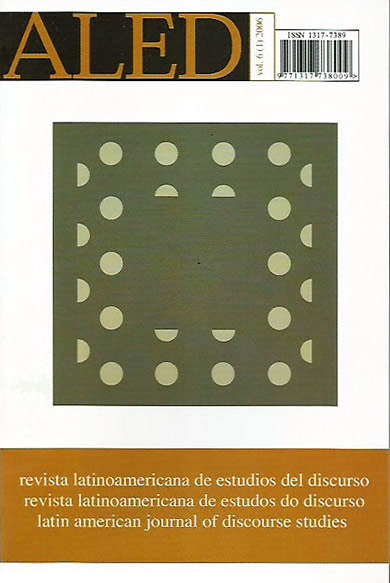La construcción del signo “indigente” en el discurso de las instituciones estatales de la Ciudad de Buenos Aires
Keywords:
critical discourse analysis. qualitative methodology. program of social emergency. “homelessl”. discursive construction.Abstract
This paper forms part of a linguistic research on the role of oral discourse in the construction of relationships between the members of a social emergency program of the government of the city of Buenos Aires. The analysis revealed that there is a conflict between participating members (social workers and psychologists). The conflict is related to the value given to “homeless” as a sign. Regardless of its historic meaning, social workers assign it the value of “destitute” while psychologists regard it as “psychotic”. As from this argument, within the theoretical framework of Critical Discourse Analysis and by means of a qualitative methodology (Fairclough & Wodak, 1997), we analyzed the discursive strategies used to build the image of “homeless” people in case reports produced by these professionals. Then, the discursive strategies were interpreted in relation to the social practices that serve as their frame and support.
Downloads
References
ALDESTEIN, A. (1996) Enunciación y crónica periodística. Buenos Aires: Ars.
ALTHUSSER, L. ([1971]1988) Ideología y aparatos ideológicos de estado.BuenosAires: Nueva Visión.
FAIRCLOUGH, N. (1992) Discourse and Social Change. Cambridge: Polity Press.
FAIRCLOUGH, N. ([1993]1999) ‘El Análisis Crítico del Discurso y la mercantilización del discurso público: las universidades’, en J. Zullo, M. Szretter, K. Sánchez, A. Raiter, P. García & V. Belloro (trad. y ed.) El Análisis Crítico: Fundamentos y Actualizaciones empíricas, pp. 49-66. Buenos Aires:Talleres gráficos de la Facultad de Filosofía y Letras de la Universidad deBuenos Aires.
FAIRCLOUGH, N. & WODAK, R. (1997) ‘Critical Discourse Analysis’, enT.A. van Dijk (ed.) Discourse as social interaction, vol. 2, pp. 258-284.London: Sage.
FANON, F. ([1961]1974) Los condenados de la tierra. Buenos Aires: Fondo deCultura Económica.
FOUCAULT, M. ([1975]1991) Vigilar y Castigar: nacimiento de la prisión.BuenosAires: Siglo Veintiuno Editores.
HODGE, R. & KRESS, G. ([1979]2000) ‘Language as ideology’, en J. Zullo, V.Unamuno, A. Raiter, S. I. Pérez y M. Bannon (trads.) Cuadernos de Sociolingüística y Lingüística Crítica II. Buenos Aires: Talleres gráficos de La Facultad de Filosofía y Letras de la Universidad de Buenos Aires.
LAVANDERA, B (1985) ‘Decir y aludir: una propuesta metodológica’, Filología 19(2): 21-31.
ONFRAY, M. (1998) Política del Rebelde: Tratado de la resistencia y la insumisión.Buenos Aires: Perfil.
PARDO, L. (2005)‘Análisis Crítico del Discurso: un estudio sobre la corrupcióny la indigencia en la Argentina’, en A. M. Harvey (comp.) En torno al discurso. Contribuciones de América Latina, pp. 194-207. Santiago de Chile: Ediciones Universidad Católica de Chile.
RAITER, A. (1999) Lingüística y Política.Buenos Aires: Biblos.
VOLOSHINOV, V. ([1926]1992) El marxismo y la filosofía del lenguaje. Madrid: Alianza.
WILLIAMS, R. ([1977]1990) Marxism and Literature. Oxford: Oxford UniversityPress.ZULLO, J. (2002) ‘¿Ser o estar pobres? Estados, procesos y acciones en la relaciónEstado-pobreza’, en A. Raiter, J. Zullo, K. Sánchez, M. Szretter, M. Basch,V. Belloro, S. I. Pérez & P. García, Representaciones Sociales, pp. 75-89. Buenos Aires: Eudeba.
Downloads
Published
How to Cite
Issue
Section
License

This work is licensed under a Creative Commons Attribution-NonCommercial-NoDerivatives 4.0 International License.
The authors retain the copyright and guarantee RALED the right to be the first publication of the work as well as a Creative Commons Attribution License that allows others to share the work with recognition of authorship and the initial publication in this journal.




